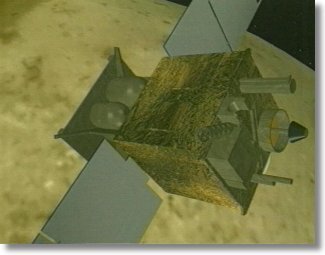While Pathfinder and Sojourner were making history on Mars, a second American spacecraft, Global Surveyor, was orbiting overhead.

One key instrument has been "MOLA" which fires a burst of laser light down to the Martian surface.
Circling the planet, "MOLA" fires a burst of laser light down to the Martian surface.
By knowing the spacecraft's position and how long it takes for the return signal, you can caluclate the exact elevation of the Martian surface.
MOLA returns 900,000 measurements a day.
It's shown us the exact height of the giant volcano, Olympus Mons...
We now know that while the Southern part of the planet is high...heavily cratered...and old...
The North is comparatively young...low...and flat.
Through "MOLA" we've been able to follow channels from Valles Marineris out into the Northern lowlands.
Researchers wonder if water once flowed down through here, out to a vast Martian ocean.
|
Jim Garvin Just like Lewis and Clark charted our continent nearly two hundred years ago, Mars Global Surveyor and the measurements we're making are charting our brother planet. Which is a target, we believe, for human exploration. And this charting, is being done at almost unimaginably fine scales. So our legacy now is to inventory and capture the nature of the skin of Mars so that future robots and people can go there, and live and work on that body. |
Last but my no means least is the "Mars Orbiter Camera."
Built from spares left over from an earlier Mission, it's been sending back pictures of objects as small as five feet.
It's shown us dust devils...
A happy face...
A Valentines' Day greeting card...
Each one of these-as well as the infamous "Face on Mars"-are natural rock formations shaped by blowing wind, sand and dust.
Some researchers think there are also clear signs that water gushed out from below the surface, at the edge of canyons and craters, and formed gullies, washing rocks and dirt downhill, leaving distinctive patterns...
They even think these gullies may have formed very recently-that perhaps there's liquid water quite close to the surface today!
As so often happens in cutting-edge science, "More research is needed..."
But, perhaps, after a century of speculation, at last we've found water-carrying channels on Mars that are science fact, not science fantasy.
![]()